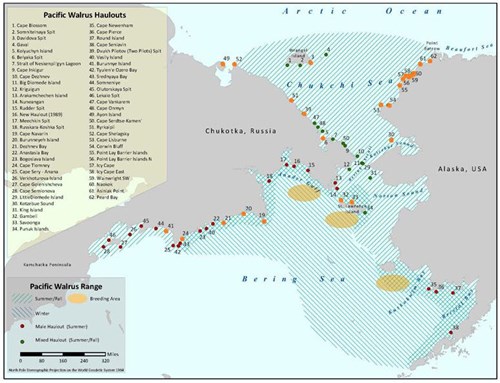Our project combines modern, historic, and ancient data that spans the last 2,000 years to help us better understand how Pacific walrus (Odobenus rosmarus) populations react to both warming and cooling trends in the Arctic. This 2,000 year time span covers not only our present conditions, but two warmer climate periods (known colloquially as the Roman Warm and Medieval Warm), as well as a cooler period (Little Ice Age). Integrating archaeology, ethnology, biology, ecology, and traditional ecological knowledge, our team will assemble long-term trends of walrus diet, foraging location, stress response, and stock genetics over the last 2,000 years. Each type of data will act as a piece of the puzzle, to give us a clearer picture of change and response to change through time in the Pacific walrus population.
Why are we doing this? Obviously we like walruses and we care about the health of our Arctic ecosystems; but there is another serious side to this that goes beyond how one species tolerates climate change. The walrus is an important part of the Arctic ecosystem and this ecosystem includes humans. Walruses are actually an important component of the subsistence harvest for many coastal communities in Alaska and other areas of the North. We hope our research will help these communities plan for a sustainable future and understand the impact that current changes in the Arctic will have on a key resource.

Pacific walrus haulout locations. Orange dots denote haulouts that are new or have increased substantially in size since 2006 (adapted from Robards and Garlich-Miller 2013).
Selecting, sampling, and preparing of historic walrus bone samples from the University of Alaska Museum of the North is well under way. Over 80 samples from individual walruses are currently being processed for steroid hormone, stable isotope, trace element, and DNA analyses. Skeletons available at the museum were collected from the 1930s-1960s, and include male and female walruses of all ages.
We also received a tremendous response from subsistence hunters this year (2014), who collected blood, blubber, muscle, whiskers, teeth, and bone from 50 walruses. We are beginning to process these samples now. Thanks to all subsistence harvesters and to the EWC, NSB, and ADF&G for their efforts in coordinating the sample collection in support of our research.
We have made inroads in recording traditional ecological knowledge as well. With the help of our partners at the Rasmuson Library at the University of Alaska Fairbanks, we have now digitized and transcribed 54 tape recordings housed within the Oral History Archives. We selected these tapes, because all the interviewees mentioned walruses in some way. We are thrilled that these time stamped transcripts are now available to all who might be interested in learning more from elders, hunters, artists, etc. about life in coastal communities over the last 50+ years.